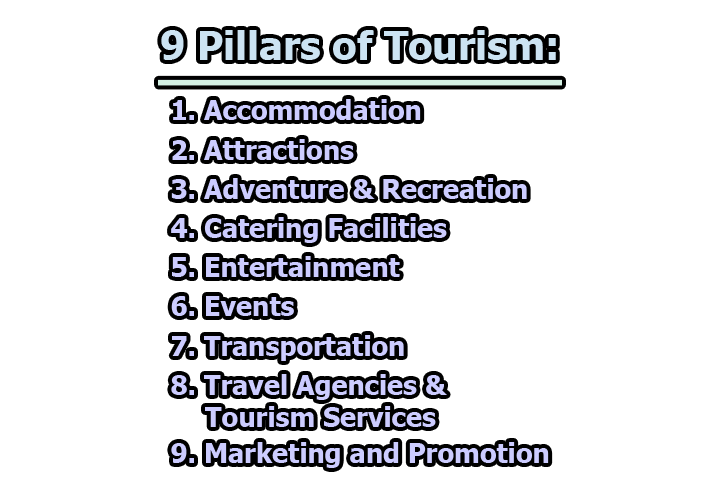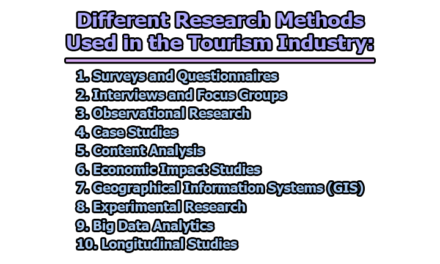9 Pillars of Tourism:
The “9 Pillars of Tourism” represent the foundational components of the global tourism industry, each playing a vital role in shaping the experiences of travelers and the economic well-being of destinations. These pillars encompass a wide spectrum of services, attractions, and logistics that collectively define the tourism ecosystem. From accommodation and attractions that draw tourists in, to entertainment and events that enhance the visitor experience, the significance of each pillar is undeniable. In this article, we delve into the essence of these pillars, elucidating their individual roles and their collective impact on the thriving and dynamic world of tourism.
1. Accommodation:
Accommodation is one of the fundamental pillars of the tourism industry, as it addresses the essential need for travelers to find a comfortable place to rest, sleep, and relax during their journeys. The type and quality of accommodation options available in a destination can significantly impact the overall experience of tourists. Here’s a brief look at accommodation in the context of tourism:
1.1 Types of Accommodation:
- Hotels: Hotels are perhaps the most recognizable form of accommodation in the tourism industry. They come in a wide range of categories, from budget hotels and motels to luxury 5-star establishments. Hotels provide travelers with a comfortable and often standardized experience, offering amenities like room service, housekeeping, restaurants, and concierge services. They cater to various budget levels and preferences.
- Resorts: Resorts are typically larger properties situated in picturesque locations, often near beaches, mountains, or natural attractions. They offer not only accommodations but also a wide array of amenities and services, such as spa treatments, water sports, and entertainment. Resorts are known for their all-inclusive packages that provide guests with a comprehensive vacation experience.
- Hostels: Hostels are popular among budget travelers, particularly younger backpackers. They offer dormitory-style accommodations with shared facilities like bathrooms and kitchens. Hostels emphasize affordability, often with communal spaces where guests can socialize and exchange travel tips. Some hostels also offer private rooms for those seeking more privacy.
- Vacation Rentals: Vacation rentals include privately-owned homes, apartments, cabins, and cottages that travelers can rent for short-term stays. Platforms like Airbnb and Vrbo have made vacation rentals increasingly popular, as they allow tourists to experience a destination from a more local perspective. Vacation rentals often provide more space and amenities for longer stays.
- Campgrounds: For travelers who enjoy the outdoors, campgrounds offer a way to connect with nature. These can range from basic facilities with minimal amenities to well-equipped campgrounds with showers, electricity, and recreational areas. Campgrounds are especially popular among hikers, campers, and RV enthusiasts.
1.2 Significance: The significance of accommodation in the tourism industry cannot be overstated. It fulfills the basic need for shelter and comfort, making it possible for tourists to explore and enjoy destinations. Here are some key points illustrating its importance:
- Tourist Experience: The quality of accommodation can significantly influence a traveler’s overall experience. A comfortable and well-maintained place to stay enhances the enjoyment of the trip.
- Economic Impact: Accommodation facilities are a source of substantial revenue in the tourism sector. They create jobs, support local businesses, and contribute to the destination’s economic growth.
- Diversity and Inclusivity: Offering a variety of accommodation options ensures inclusivity in tourism, catering to travelers with different budgets, preferences, and travel styles. This diversity allows destinations to attract a broader range of tourists.
- Destination Attractiveness: The availability of high-quality accommodations is a key factor in a destination’s attractiveness. It can be a deciding factor for tourists when choosing their travel destinations.
2. Attractions:
Attractions are the primary motivators that draw travelers to specific destinations. They encompass a wide range of features, both natural and man-made, that capture the interest and curiosity of tourists. Here’s a closer look at the significance of attractions in tourism:
2.1 Types of Attractions:
- Natural Attractions: These include awe-inspiring natural wonders such as mountains, beaches, waterfalls, deserts, and national parks. The beauty and uniqueness of these sites often make them the centerpiece of a destination’s tourism industry.
- Cultural Attractions: Cultural landmarks, historical sites, museums, and heritage districts offer insights into a destination’s history, traditions, and art. These attractions help visitors connect with the local culture and heritage.
- Adventure Attractions: Some tourists seek thrilling experiences in the form of adventure activities like hiking, rock climbing, zip-lining, and water sports. Destinations with rugged landscapes and outdoor adventures often appeal to adventure enthusiasts.
- Entertainment Attractions: Theme parks, theaters, and live performances provide entertainment and amusement. Theme parks, in particular, are designed to offer a wide array of rides, shows, and themed experiences.
2.1 Significance: Attractions are the heart and soul of the tourism industry. They serve as the primary reasons people choose to travel and explore new places. Here are some key points highlighting their importance:
- Motivation to Travel: Attractions provide the motivation for travelers to visit a particular destination. The desire to see and experience these attractions is what drives tourism.
- Cultural Exchange: Cultural attractions allow tourists to engage with local traditions, art, and history. They promote cross-cultural understanding and appreciation.
- Economic Impact: Attractions often result in substantial visitor spending on entrance fees, guided tours, souvenirs, and local businesses, which, in turn, boost the local economy.
- Conservation and Preservation: The popularity of natural attractions often leads to conservation efforts to protect these sites. Cultural attractions can also contribute to the preservation of historical and architectural heritage.
3. Adventure & Recreation:
Adventure and recreation activities provide tourists with opportunities to engage in exciting and enjoyable experiences during their travels. These activities cater to a wide range of interests, allowing destinations to appeal to various types of travelers. Here’s an exploration of this pillar:
3.1 Types of Activities:
- Adventure Sports: These activities are designed to provide an adrenaline rush. Examples include whitewater rafting, rock climbing, skydiving, bungee jumping, and zip-lining. Adventure sports are particularly appealing to thrill-seekers.
- Outdoor Adventures: For nature enthusiasts, outdoor adventures like hiking, camping, biking, and wildlife safaris offer a chance to connect with the environment. These activities often take place in national parks, forests, and scenic landscapes.
- Wellness and Spa: Travelers looking for relaxation and rejuvenation often seek wellness and spa experiences. These can include massages, yoga retreats, hot springs, and wellness-focused retreats.
- Sports and Recreational Facilities: Destinations with golf courses, tennis courts, and sports facilities attract tourists interested in active recreation. Golf, in particular, is a sport that draws travelers to specific destinations.
3.1 Significance: Adventure and recreation activities contribute to the diversity of a destination’s tourism offerings, making it more appealing to a broad range of travelers. Here’s why this pillar is essential:
- Diverse Appeal: Adventure and recreation activities cater to a wide spectrum of tourists, from adventure enthusiasts and nature lovers to wellness seekers and sports enthusiasts.
- Length of Stay: Engaging activities often encourage longer stays in a destination. Travelers may spend more time exploring and participating in recreational pursuits.
- Destination Differentiation: Adventure and recreation options can set a destination apart from its competitors. Unique activities create a compelling reason for tourists to choose one location over another.
- Local Engagement: These activities often involve interactions with local guides and service providers, which can promote cultural exchange and support local businesses.
4. Catering Facilities:
Catering facilities play a significant role in the tourism industry as they encompass a wide range of dining establishments and food-related services. Travelers often seek to experience the local cuisine and taste new flavors, making catering facilities an essential aspect of the overall tourism experience.
4.1 Types of Catering Facilities:
- Restaurants: Restaurants come in various forms, from fine dining establishments to casual eateries. They offer a diverse menu, including local and international cuisine, allowing tourists to explore the culinary traditions of the destination.
- Street Food: Street food vendors and markets offer a unique way for travelers to sample authentic local flavors. This is a particularly popular option among those seeking an immersive food experience.
- Cafes and Coffee Shops: Cafes provide a cozy and relaxed setting for travelers to enjoy a cup of coffee, light snacks, or pastries. They are ideal for casual dining and coffee breaks.
- Fine Dining: Fine dining restaurants offer gourmet cuisine and often feature upscale ambiance and service. They cater to tourists looking for a high-end dining experience.
4.2 Significance: The significance of catering facilities in the tourism industry goes beyond mere sustenance; it plays a vital role in enhancing the overall tourism experience:
- Cultural Exploration: Dining at local restaurants and trying street food allows tourists to immerse themselves in the culture and culinary traditions of the destination.
- Economic Contribution: Catering facilities generate revenue and employment opportunities, supporting the local economy and food industry.
- Diverse Options: A variety of catering facilities ensures that tourists with different tastes and preferences are well-catered to, enhancing the overall appeal of the destination.
- Tourist Satisfaction: Access to high-quality dining options contributes to visitor satisfaction and can lead to positive reviews and return visits.
5. Entertainment:
Entertainment facilities are crucial for enhancing the overall tourist experience. These facilities include theaters, cinemas, music venues, and other sources of entertainment that tourists often seek in the evenings or during leisure time.
5.1 Types of Entertainment Facilities:
- Theaters and Concert Halls: These venues host live performances, including plays, musicals, concerts, and other cultural events. They provide opportunities for tourists to enjoy the performing arts.
- Cinemas: Cinemas screen movies, including local and international films. For travelers, catching a film can be a leisurely way to spend an evening or a rainy day.
- Nightclubs and Bars: Nightlife is a significant attraction for many tourists. Nightclubs and bars offer entertainment, music, and dancing, making them popular choices for those seeking lively social experiences.
- Cultural Shows: In destinations rich in cultural traditions, tourists can attend cultural shows that feature traditional dance performances, music, and local art displays.
5.2 Significance: Entertainment facilities contribute to the overall enjoyment of a destination and offer tourists diverse options for leisure and cultural enrichment. Here are some reasons why entertainment is important in tourism:
- Leisure and Relaxation: After a day of exploring, tourists often seek entertainment facilities to unwind, socialize, and have fun.
- Cultural Exchange: Cultural shows and live performances allow tourists to engage with local traditions and artistic expressions.
- Economic Impact: Entertainment facilities contribute to the local economy by generating revenue from ticket sales, food and beverage services, and merchandise.
- Nightlife and Social Interaction: Nightclubs and bars are essential for the vibrant nightlife that many tourists look for in a destination. They promote social interactions and contribute to the city’s atmosphere.
6. Events:
Events represent a diverse range of gatherings that attract a substantial number of visitors to a destination. These occasions can be cultural festivals, sporting events, conferences, or seasonal celebrations, and they often play a significant role in shaping a destination’s identity.
6.1 Types of Events:
- Cultural Festivals: Cultural festivals celebrate a destination’s unique traditions, music, art, and cuisine. They often showcase the local culture and heritage, providing tourists with an immersive experience.
- Sporting Events: Sporting events draw sports enthusiasts and fans to a destination. Whether it’s a major tournament or a local competition, sports events can lead to a surge in tourism.
- Conferences and Expos: Professional conferences, trade shows, and expos bring industry experts and business travelers to a destination. These events can have a considerable impact on the local economy.
- Seasonal Celebrations: Seasonal events, including holiday festivals, parades, and special celebrations, create a sense of festivity and can attract tourists during specific times of the year.
6.2 Significance: Events have a substantial impact on tourism and the local community. Here’s why events are an essential pillar of tourism:
- Tourism Peaks: Events often result in surges in visitation, boosting the local tourism industry, accommodation bookings, and the demand for catering and entertainment services.
- Economic Boost: Events can stimulate the local economy by generating revenue from ticket sales, merchandise, and associated businesses, such as restaurants and shops.
- Community Engagement: Events encourage community participation and contribute to the cultural vibrancy of the destination.
- Identity and Promotion: Events can help shape a destination’s identity and provide opportunities for promotion, attracting tourists and media attention.
7. Transportation:
Efficient transportation systems are the lifeblood of the tourism industry, as they are responsible for ensuring that tourists can reach their chosen destinations conveniently and safely. Transportation encompasses various modes of travel, including air, road, rail, and maritime transport.
7.1 Types of Transportation:
- Air Travel: Airlines play a central role in connecting destinations, both domestically and internationally. Airports serve as gateways for travelers, offering a wide range of flights and routes to various destinations.
- Road Networks: Efficient road networks, including highways and well-maintained roads, provide tourists with the flexibility to explore a destination by car, bus, or other ground transportation options.
- Railways: Trains and metro systems are vital for urban transportation and connecting different regions within a country. Trains can offer scenic journeys and a unique way to experience a destination.
- Maritime Transport: For destinations near the coast or with accessible waterways, maritime transport includes ferries, cruise ships, and boats that provide an alternative and scenic means of travel.
7.2 Significance: Transportation is a crucial pillar of tourism for several reasons:
- Accessibility: Efficient transportation systems make it possible for tourists to access and explore a wide range of destinations, boosting visitation and tourism revenue.
- Connectivity: Reliable transportation links enable tourists to move seamlessly between regions, cities, and attractions, enhancing the overall tourist experience.
- Economic Impact: The transportation sector contributes to the local economy through employment, infrastructure development, and the support of related businesses such as hotels, restaurants, and car rentals.
- Logistics and Convenience: Tourism transportation services provide convenience and ensure that travelers can access services such as airport transfers, car rentals, and guided tours.
8. Travel Agencies & Tourism Services:
Travel agencies and tourism services play a pivotal role in facilitating tourists’ journeys by providing a range of essential services, including travel planning, booking, and support during trips. They ensure that travelers have a seamless and enjoyable experience.
8.1 Types of Tourism Services:
- Travel Agencies: Travel agencies assist travelers in planning their trips, booking accommodations, transportation, and tours, and providing expert advice on destinations and travel regulations.
- Tour Operators: Tour operators offer packaged tours and experiences, often with specific itineraries, activities, and group travel options, making travel planning more accessible for tourists.
- Travel Insurance: Travel insurance providers offer coverage for unexpected events during trips, such as trip cancellations, medical emergencies, and lost luggage, giving tourists peace of mind.
- Visa and Passport Services: These services assist travelers with obtaining the necessary travel documentation, including visas, passports, and permits, ensuring smooth international travel.
8.2 Significance: Travel agencies and tourism services are integral to the tourism industry for the following reasons:
- Travel Convenience: These services simplify the travel planning process, saving tourists time and effort in arranging various aspects of their trips.
- Expert Guidance: Travel agencies and tour operators provide valuable insights into destinations, helping travelers make informed decisions about their journeys.
- Risk Mitigation: Travel insurance protects tourists from unforeseen events and provides financial security during their trips.
- Documentation Assistance: Visa and passport services ensure that travelers have the necessary documents for international travel, reducing potential hurdles and complications.
9. Marketing and Promotion:
While not always explicitly mentioned as one of the “pillars,” marketing and promotion are critical components of the tourism industry. Effective marketing strategies are essential for attracting and retaining tourists. Marketing includes destination promotion, online presence, and branding efforts to engage potential travelers.
9.1 Marketing Strategies:
- Digital Marketing: Utilizing websites, social media, and online advertising to reach a wide audience of potential tourists and inspire travel interest.
- Destination Promotion: Showcasing the unique features, attractions, and experiences a destination offers through brochures, websites, and multimedia campaigns.
- Collaborations and Partnerships: Collaborating with airlines, hotels, and other businesses to create attractive packages, discounts, and special offers.
- Tourism Campaigns: Launching marketing campaigns to promote special events, seasonal attractions, or unique aspects of the destination.
9.2 Significance: Marketing and promotion efforts play a critical role in the success of the tourism industry:
- Awareness and Interest: Effective marketing efforts create awareness and generate interest in a destination, enticing travelers to consider visiting.
- Visitor Flow: Marketing can help distribute tourists more evenly throughout the year by promoting specific events or attractions during off-peak seasons.
- Economic Growth: Increased visitation resulting from successful marketing campaigns leads to higher revenue for the tourism sector, local businesses, and the destination as a whole.
- Competitive Edge: In a competitive market, effective marketing can set a destination apart from its competitors, making it a more attractive choice for travelers.
In conclusion, the “9 Pillars of Tourism” are not mere isolated elements but intricately woven threads that constitute the fabric of the tourism industry. Accommodation ensures travelers find comfort and rest, attractions serve as magnets drawing tourists, and adventure and recreation cater to diverse interests. Catering facilities offer a taste of local culture, while entertainment keeps tourists engaged after hours. Events create tourism peaks, transportation links it all, travel agencies provide support, and marketing and promotion weave a compelling narrative. Understanding the significance of each pillar and their symbiotic relationships is essential for stakeholders to create memorable, vibrant, and sustainable tourism experiences for all. These pillars collectively support the ever-evolving tourism industry, which continues to captivate the imagination of travelers worldwide.

Library Lecturer at Nurul Amin Degree College










